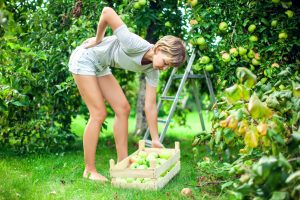
The birds are singing. The sun is shining. And your fingers are desperate to get busy in your garden. But before you dive into another season of gardening and everything that comes with it, you’ll want to ensure every gardening session is pain-free.
While tending to the garden offers a low-impact and fun activity right on your doorstep, unfortunately, with any form of exercise, there is a risk of injury — and gardening injuries are more common than you think!
Common Gardening Injuries
Gardening injuries are sneaky—you often don’t realise you’ve hurt your body until it’s too late. So, let’s look at some of the most common ones you should watch out for.
- Back and Neck Injuries: Bending, twisting, working above shoulder height, or holding your body at an awkward angle for too long can strain the soft tissue around your spine.
- Knee Injuries: Prolonged kneeling isn’t a natural body position and can lead to terrible pain.
- Repetitive Injuries: Repetitive activity involving your elbows, wrists, or shoulders can cause aches — and even tendonitis in more severe cases.
- Slips and Falls: If you stretch, lose your balance, or lose awareness of your surroundings, it can lead to a serious fall. Even a minor slip can cause jarring and soft tissue damage in your body.
- Garden Tool Injuries: Operating heavy tools, like chainsaws, can save you time, but it can also lead to very serious injuries.
- Dehydration and Sunburn: Losing yourself in your garden work for hours is great for your mind but it takes a toll on your body — especially when you work in the sun.
The good news is that there are simple ways to garden safely so your green fingers can keep busy and your garden — and health — can thrive!
5 Ways to Prevent Spring Gardening Injuries
Consider these simple gardening tips to help you enjoy all the benefits of gardening without pain.
1. Warm Up & Prepare Accordingly
Gardening is a workout, so take time to warm up your muscles before you dig in. A simple walk outside and a few stretches are sufficient!
Choose gardening tools that make the work less taxing on your joints — but be sure they’re not too heavy for you to handle. Sharpen the blades of your pruning shears. Use a step ladder to keep your work at chest height. Wear gloves to protect your fingers from scratches and closed shoes with a good grip.
2. Perfect Your Posture
Your posture is vital to avoid most gardening-related injuries and muscle pain. Keep your spine neutral — in a natural straight position — by bending with your knees rather than at your waist. Avoid twisting while you work. And try not to kneel for long periods — rather, sit on the ground or a stool while you work at ground level.
3. Plan and Rotate Your Tasks
Cycle through your gardening tasks a few times per session. Alternate your activities to protect yourself from repetitive injuries that harm your joints — you’ll find the work more stimulating, too! Mow, prune, weed, repeat.
4. Pace Yourself
Don’t overdo it! At the beginning of the season, start with smaller periods and increase them as you build up stamina. Listen to your body and change your position or stop if you experience aches or discomfort.
5. Prioritise Your Comfort
Consider ways to be more comfortable while you garden. Wear lightweight clothing and a hat, keep drinking water on hand, and use good gloves, tools, and a sturdy step ladder to protect your body.
Gardening is a great way to move your body and strengthen your mind — if you take care to do it safely. Don’t let injuries or pain prevent you from getting your hands dirty outside. Our team at Bradford House Chiropractic & Wellness Centre is ready to help you. Contact us today to book your appointment and take your first step back into the hobby you love!









